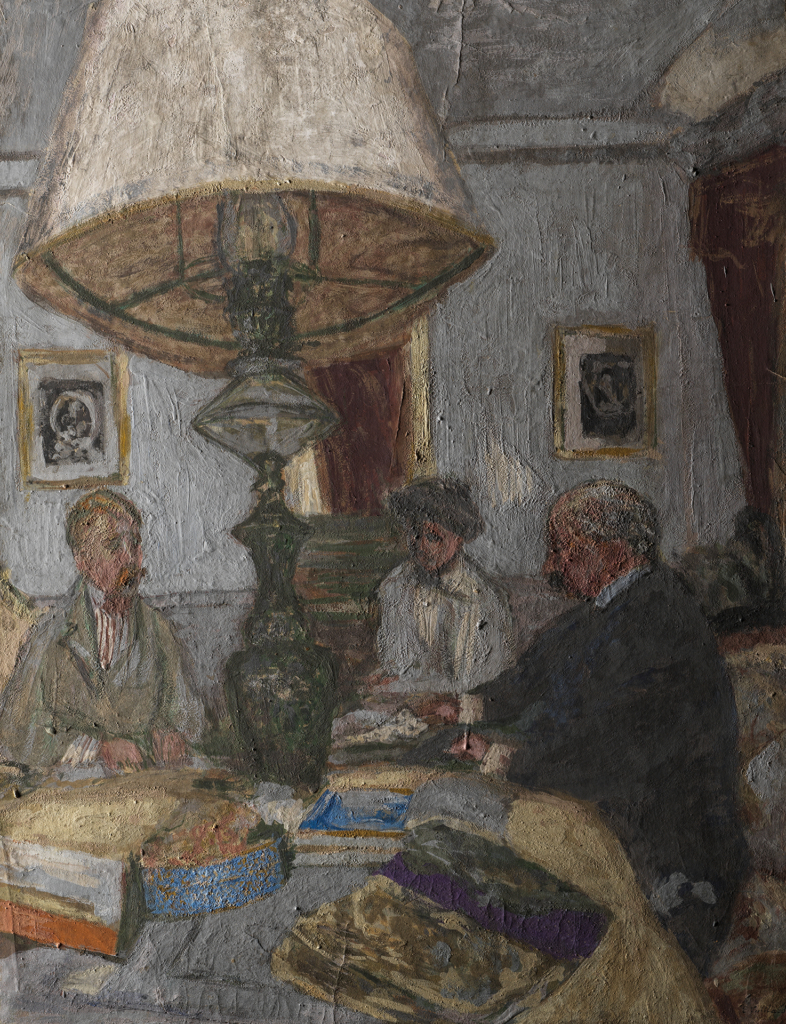
| X (Twitter) | |
|---|---|
URL kopieren
Die URL wurde erfolgreich kopiert und befindet sich in der Zwischenablage |
|
Aus urheberrechtlichen Gründen können wir die Werkabbildung leider nicht zum Download bereitstellen.
Hier erfahren Sie mehr.Under the Great Lamp
Edouard Vuillard
KunsthalleKarlsruhe@ZKM
A story of means and mediators
0:00
0:00
Media in exchange
If you were to photograph a small group of friends around a table, would you snap the picture from below into a boring run-of-the-mill lamp that would then tower over everything else in the picture? Probably not. You would likely choose a better point of view, a different angle. Or you would simply move the lamp a bit out of the foreground. But why didn’t the painter do that here?
Perception and implementation
Vuillard never let his models pose, he surprised them in their homes, in their familiar surroundings. […] the painter said to them: ‘Don’t move anymore, stay as you are!’ Then he made a sketch. And in this first idea, the whole painting was already to be found.
Antoine Salomon, a relative of Edouard Vuillard and later author of his catalog raisonné, describes here the fascinating web of perception and artistic transformation of a motif.
The lamp is the star
The Kunsthalle’s collection also includes the drawing on which this painting is based — that first idea of which Salomon spoke. In it, Vuillard captured a placid scene: members of the Hessel family, his friends, are sitting together at a table in their summer villa in Saint-Jacut. Already in the drawing with its quick, almost searching and jumping pencil and ink lines, the lamp forms the centre of the composition seen from below. The people gather around it. However, its glow does not atmospherically bathe the room in soft light, nor does its cone unite the group, as painterly tradition would have demanded. Instead, it almost obtrusively dominates the composition and marks off the room’s areas and the people from one another.
This becomes even clearer when compared to two other versions of the lamp at Saint-Jacut, which are done in a calm horizontal format. By choosing a vertical format for the Karlsruhe painting and thus additionally emphasising the height of the lamp, Vuillard made the pictorial idea more radical. Why?
A different point of view
Probably Vuillard’s preoccupation with another medium was the reason — he was not only a painter, but also a passionate amateur photographer. The Eastman Kodak company had developed a simple pocket camera using rollfilm and when it came on the market Vuillard immediately purchased one [link Vuillard with camera]. The small box of the Pocket Kodak was not held at eye level, but rather in front of the stomach, and one looked down into it. In this way, the subject was captured from below.
Perfect picture! Painting with a photographer’s eye
With this type of analogue photography issues of image detail and perspective arose differently than in painting, where locations could be chosen more freely and reality could be adjusted much more during the process of painting. Possibilities that Vuillard deliberately did not use in this painting. Here, the fidelity of what he saw is transferred to a painting, which makes this work an extraordinary reference to media history. This is also because Vuillard combined the photographer’s gaze with the painter’s fine sense of materials and techniques: he used distemper to create matte, chalky surfaces that stand next to and on top of each other in places, which give the painting its special effect.
Dates and facts
| Title | Under the Great Lamp |
|---|---|
| Artist | Edouard Vuillard |
| Date | |
| Measurements Painting | |
| Material |